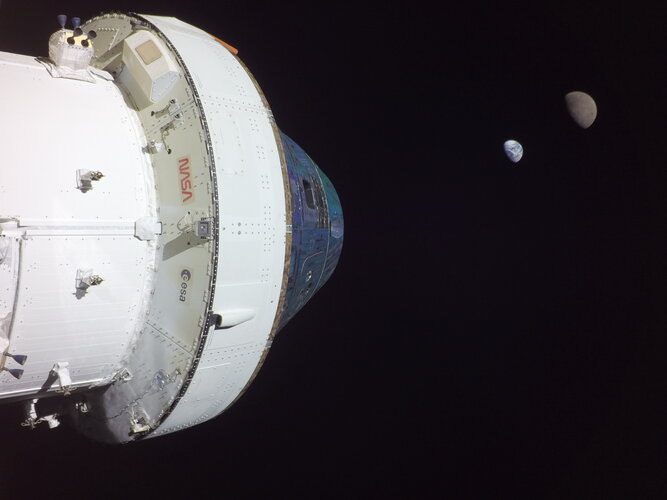The Orion capsule looks back at Earth and the Moon as it sets an epic record. The NASA spacecraft was some 430 000 km from our home planet and over 64 000 km from the Moon – the farthest any spacecraft built for humans has ever travelled.
The trio seems to be posing for a ‘family portrait’ on their way to making history, beating the record set by the Apollo 13 mission over half a century ago.
A year has passed since the Artemis I mission travelled to the Moon and back powered by the European Service Module. NASA’s mega Moon rocket roared into the night and onto the Moon on 16 November 2022. The Space Launch System lifted off from the Kennedy Space Center in Florida, USA, and put the uncrewed Orion spacecraft into Earth orbit.
During the 25-day mission, the European powerhouse fired its 33 engines to keep Orion on course and supplied electricity during the lunar trip. Much like a train engine pulls passenger carriages and supplies power, the European Service Module took the Orion capsule to its destination and back, including a flyby of the Moon.
This photo was taken halfway through the mission by a camera fastened to the end of a seven-metre long solar arrays. The four wings of the module were used as ‘selfie sticks’ to capture spectacular images. The ESA logo can be seen during the lunar orbit cruise.
The European Service Module separated from Orion in the last hours of its approach back to Earth. Without a heat shield to protect it from the friction of entering our planet’s atmosphere, the service module burned up harmlessly over the Pacific Ocean.
The Orion crew module returned to Earth 24 times faster than a speeding bullet for a safe splashdown. Using a skip entry technique, the capsule landed off the coast of Baja California, Mexico, on 11 December 2022. The first flight of the Artemis series was a success.
The module crafted by ESA and industry teams from more than 20 companies in ten countries across Europe excelled in its performance during the two-million-kilometre journey, saving 25% of the propellant and generating about 15% more power than expected. The module responded so well that NASA teams asked European engineers to perform additional tests to push the spacecraft to its limits.
Europe is powering humankind’s return to the Moon with the serial production of the European Service Module. The second powerhouse has recently been integrated with its crew module for the Artemis II mission. Together as one, both modules are completing several tests in preparation for a flight that will see three NASA astronauts and one CSA astronaut (Canadian Space Agency) orbiting the Moon.
Look back at the best moments of the European Service Module during the first anniversary of the Artemis I mission on ESA’s Orion blog.



 Image:
Over the Moon, one year later
Image:
Over the Moon, one year later